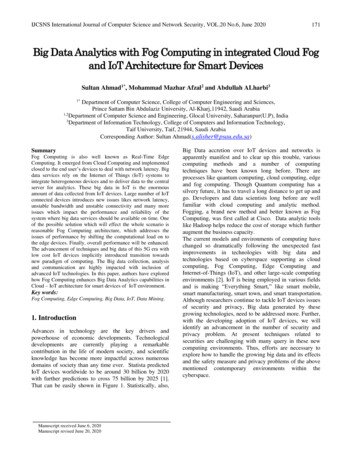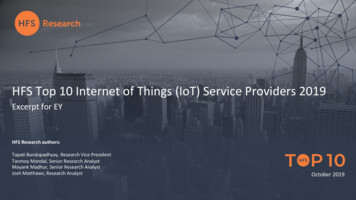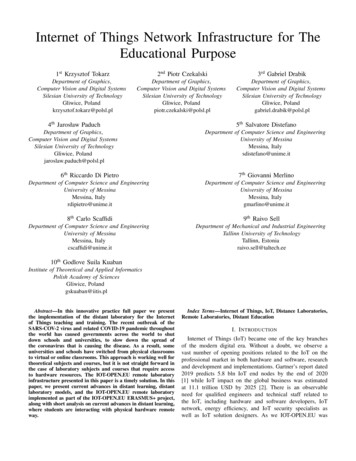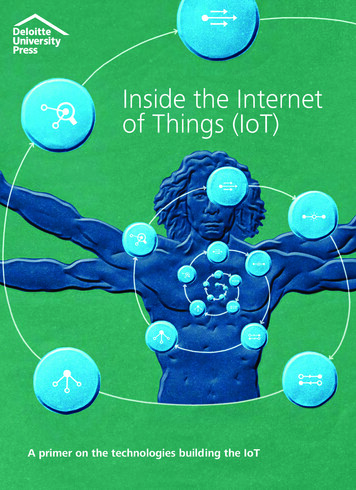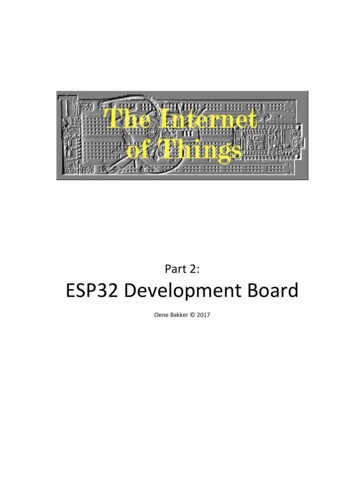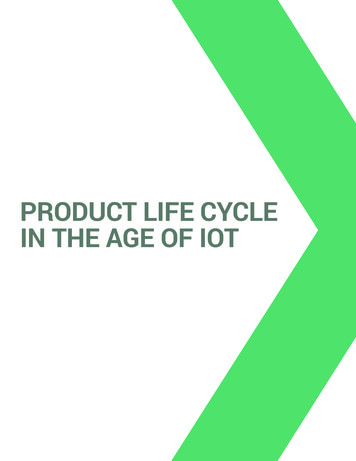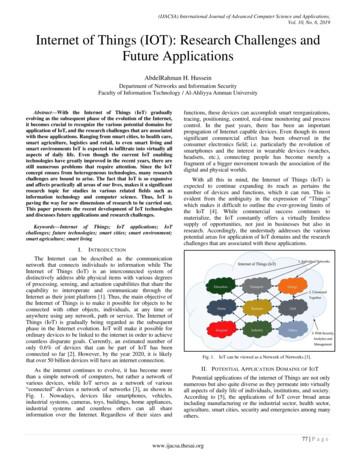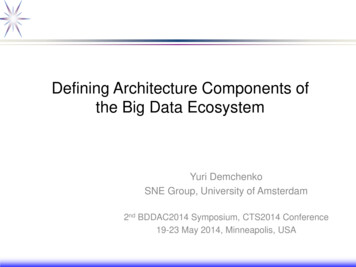
Transcription
IoT and Big Data: An Architecturewith Data Flow and Security IssuesDeepak Puthal1 , Rajiv Ranjan2, Surya Nepal3, and Jinjun Chen4()1School of Computing and Communications, University of Technology Sydney,Ultimo, Australiadeepak.puthal@gmail.com2School of Computing Science, Newcastle University, Newcastle upon Tyne, UKrranjans@gmail.com3CSIRO Data61, Canberra, AustraliaSurya.Nepal@data61.csiro.au4Swinburne Data Science Research Institute, Swinburne University of Technology,Melbourne, Australiajinjun.chen@gmail.comAbstract. The Internet of Things (IoT) introduces a future vision where users,computer, computing devices and daily objects possessing sensing and actuatingcapabilities cooperate with unprecedented convenience and benefits. We aremoving towards IoT trend, where the number of smart sensing devices deployedaround the world is growing at a rapid speed. With considering the number ofsources and types of data from smart sources, the sensed data tends to new trendof research i.e. big data. Security will be a fundamental enabling factor of mostIoT applications and big data, mechanisms must also be designed to protectcommunications enabled by such technologies. This paper analyses existingprotocols and mechanisms to secure the IoT and big data, as well as securitythreats in the domain. We have broadly divided the IoT architecture into severallayers to define properties, security issues and related works to solve the securityconcerns.Keywords: Internet of Things · Big data · Security · Security threats · Quality ofService1IntroductionIoT is a widely-used expression but still a fuzzy one, due to the large number of conceptsbrought together to a concept. The IoT appears a vision of a future source of data wheresensing device, possessing computing and sensorial capabilities can communicate withother devices using Internet protocol. Such applications are expected to bring a largetotal of sensing and actuating devices, and in significance these costs will be a majorfactor. On the other hand, cost restrictions dictate constraints in terms of the resourcesavailable in sensing platforms, such as memory and computational power. Overall, suchfactors motivate the design and adoption of communications and security mechanisms ICST Institute for Computer Sciences, Social Informatics and Telecommunications Engineering 2018A. Longo et al. (Eds.): IISSC 2017/CN4IoT 2017, LNICST 189, pp. 243–252, 2018.https://doi.org/10.1007/978-3-319-67636-4 25
244D. Puthal et al.optimized for constrained sensing platforms, capable of providing its functionalitiesefficiently and reliably.Several of these applications are approaching the bottleneck of current datastreaming infrastructures and require real-time processing of very high-volume andhigh-velocity data streams (also known as big data streams). The complexity of big datais defined through 5Vs: (1) volume– referring to terabytes, petabytes, or even exabytes(10006 bytes) of stored data, (2) variety– referring to unstructured, semi-structured andstructured data from different sources like sensors, surveillance, image or video, medicalrecords etc., (3) velocity– referring to the high speed at which the data is handled in/outfor stream processing, (4) variability– referring to the different characteristics and datavalue where the data stream is handled, (5) veracity– referring to the quality of data.These features introduce huge open doors and enormous difficulties for big data streamcomputing. A big data stream is continuous in nature and it is important to perform realtime analysis as the lifetime of the data is often very short (data is accessed only once)[1, 2, 6, 7]. As the volume and velocity of the data is so high, there is not enough spaceto store and process; hence, the traditional batch computing model is not suitable.Even though big data stream processing has become an important research topic inthe current era, data stream security has received little attention from researchers [1, 2].Some of these data streams are analysed and used in very critical applications (e.g.surveillance data, military applications, etc.), where data streams need to be secured todetect malicious activities. The problem is exacerbated when thousands to millions ofsmall sensors in self-organising wireless networks become the sources of the datastream. How can we provide the security for big data streams? In addition, compared toconventional store-and-process, these sensors will have limited processing power,storage, bandwidth, and energy.Big data in IoT environment is gaining lots of interest from global researcher. Byfocusing current research trend, we have given the data flow between the layers includingresearch issues in IoT generated big data architecture. The main contributions of thepaper can be summarized as follows: We have proposed IoT generated big data architecture while defining layer wiseproperties of IoT. Followed by, we have highlighted the security threats, issues and solutions of indi‐vidual IoT layers. Finally, we have highlighted the security issues of big data in IoT.The rest of this paper is organized as follows. Section 2 gives the background IoTlayers and their features. Section 3 describes security threats of individual layers in IoTarchitecture. Section 4 presents the security issues and requirements in IoT generatedbig data streams. Section 5 concludes the paper.2IoT ArchitectureThe connection of physical things to the Internet makes it possible to access remotesensor data and to control the physical world from a distance. The IoT is based on
IoT and Big Data245this vision. A smart object, which is the building block of the IoT, is just anothername for an embedded system that is connected to the Internet [9]. Al-Fuqaha et al.in [10] clearly defined the individual elements of IoT, which includes identifica‐tion, sensing, communication, computation, services, and semantics. There is anothertechnology that points in the same direction as RFID technology. The novelty of theIoT is not in any new disruptive technology, but in the pervasive deployment ofsmart objects. IoT system architecture must guarantee the operations of IoT, whichbridges the gap between the physical and the virtual worlds. Since things may movegeographically and need to interact with others in real-time mode, IoT architectureshould be adaptive to make devices interact with other things dynamically andsupport unambiguous communication of events [11]. We broadly divided thecomplete architecture of IoT into three different layers, such as source smart sensingdevice, communication (Networks) layer and cloud data centre as shown in Fig. 1.These layers can be related to the service layer of IoT, where service layer and inter‐face layer are integrated into the data centre in our architecture. The service levelarchitecture of IoT consists of four different layers with functionality such as sensinglayer, network layer, service layer, and interfaces layer [11, 12]. Sensing layer: This layer is integrated with available hardware objects (sensors,RFID, etc.) to sense/control statuses of things. Network layer: This layer supports the infrastructure for networking over wirelessor wired connections. Service layer: This layer creates and manages services requirements according to theuser’s need. Interfaces layer: This layer provides interaction methods to users and applications.Fig. 1. Layer wise IoT architecture from IoT device to cloud data centre.
246D. Puthal et al.2.1 Sensing LayerIoT is expected to be a world-wide physical inner-connected network, in which thingsare connected seamlessly and can be controlled remotely. In this layer, more and moredevices are equipped with RFID or intelligent sensors, connecting things becomes mucheasier [13]. Individual objects in IoT hold a digital identity which helps to track easilyin the domain. The technique of assigning a unique identity to an object is called auniversal unique identifier (UUID). UUID is critical to successful services deploymentin a huge network like IoT. The identifiers might refer to names and addresses. Thereare a few aspects that need to be considered in the sensing layer such as deployment(devices need to deployed randomly or incrementally), heterogeneity (devices havedifferent properties), communication (needs to communicate with each other in order toget access), network (devices maintain different topology for data transmission process),cost, size, resources and energy consumption. As the use of IoT increases day by day,many hardware and software components are involved in it. IoT should have these twoimportant properties: energy efficiency and protocols [11]. Energy efficiency: Sensors should be active all the time to acquire real-time data. Thisbrings the challenge to supply power to sensors; high energy efficiency allows sensorsto work for a longer period. Protocols: Different things existing in IoT provide multiple functions of systems.IoT must support the coexistence of different communications such as ZigBee,6LoWPAN etc.2.2 Networking LayerThe role of the networking layer is to connect all things together and allow things toshare information with other connected things. In addition, the networking layer iscapable of aggregating information from existing IT infrastructures [4], data can thenbe transmitted to cloud data centre for the high-level complex services. The communi‐cation in the network might involve the Quality of Service (QoS) to guarantee reliableservices for different users or applications [5]. Automatic assignment of the devices inan IoT environment is one of the major tasks, it enables devices to perform tasks collab‐oratively. There are some issues related to the networking layer as listed below [11]: Network management technologies including managing fixed, wireless, mobilenetworks Network energy efficiency Requirements of QoS Technologies for mining and searching Data and signal processing Security and privacyAmong these issues, information confidentiality and human privacy security arecritical because of the IoT device deployment, mobility, and complexity. For informa‐tion confidentiality, the existing encryption technology used in WSNs can be extendedand deployed in IoT. Granjal et al. [3] divided the communication layer for IoT
IoT and Big Data247applications into five different parts: Physical layer, MAC layer, Adaptation layer,network/routing layer, application layers. They also mentioned the associated protocolsfor energy efficiency as shown in Fig. 2.Fig. 2. Communication protocol in IoT.2.3 Service LayerA main activity in the service layer involves the service specifications for middleware,which are being developed by various organisations. A well-designed service layer willbe able to identify common application requirements.The service layer relies on the middleware technology, which provides functionali‐ties to integrate services and applications in IoT. The middleware technology providesa cost-effective platform, where the hardware and software platforms can be reused. Theservices in the service layer run directly on the network to effectively locate new servicesfor an application and retrieve metadata dynamically about services. Most of specifica‐tions are undertaken by various standards developed by different organisations.However, a universally accepted service layer is important for IoT. A practical servicelayer consists of a minimum set of the common requirements of applications, applicationprogramming interfaces (APIs), and protocols supporting required applications andservices.2.4 Interface LayerIn IoT, a large number of devices are involved; those devices can be provided by differentvendors and hence do not always comply with same standards. The compatibility issueamong the heterogeneous things must be addressed for the interactions among things.Compatibility involves information exchanging, communication, and events processing.There is a strong need for an effective interface mechanism to simplify the management
248D. Puthal et al.and interconnection of things. An interface profile (IFP) is a subset of service standardsthat allows a minimal interaction with the applications running on application layers.The interface profiles are used to describe the specifications between applications andservices.3Security Threats of Each LayerThis subsection lists the security threats and security issues is each individual layer asdivided in the above subsections.3.1 Sensing LayerThe sensing layer is responsible for frequency selection, carrier frequency generation,signal detection, modulation, and data encryption [3, 14]. An adversary may possess abroad range of attack capabilities. A physically damaged or manipulated node used forattack may be less powerful than a normally functioning node. IoT devices use wirelesscommunication because the network’s ad hoc, large-scale deployment makes anythingelse impractical. As with any radio-based medium, there exists the possibility ofjamming in IoT. In addition, devices may be deployed in hostile or insecure environ‐ments where an attacker has easy physical access. Network jamming and source devicetampering are the major types of possible attack in the sensing layer. The features ofsensing layers follow from Fig. 2.Jamming: Interference with the radio frequencies nodes are using andTampering: Physical compromise of nodes.3.2 Network LayerThe security mechanisms designed to protect communications with the previouslydiscussed protocols must provide appropriate assurances in terms of confidentiality,integrity, authentication and non-repudiation of the information flows. Other relevantsecurity requirements are privacy, anonymity, liability and trust, which will be funda‐mental for the social acceptance of most of the future IoT applications employingInternet integrated sensing devices. According to the communication protocol in IoT,we divided in five different layer as shown in Fig. 2.MAC Layer. The MAC layer manages, besides the data service, other operations,namely accesses to the physical channel, validation of frames, guaranteed time slots,node association and security. The standard distinguishes sensing devices by its capa‐bilities and roles in the network. A full-function device (FFD) can coordinate a networkof devices, while a reduced-function device (RFD) is only able to communicate withother devices (of RFD or FFD types). By using RFD and FFD, IEEE 802.15.4 supporttopologies such as peer-to-peer, star and cluster networks [15].
IoT and Big Data249Network Layer. One fundamental characteristic of the Internet architecture is that itenables packets to traverse interconnected networks using heterogeneous link-layertechnologies, and the mechanisms and adaptations required to transport IP packets overparticular link-layer technologies with appropriate specifications. With a similar goal,the IETF IPv6 over Low-power Wireless Personal Area Networks (6LoWPAN) workinggroup was formed in 2007 to produce a specification enabling the transportation of IPv6packets over low-energy IEEE 802.15.4 and similar wireless communication environ‐ments. 6LoWPAN is currently a key technology to support Internet communications inthe IoT, and one that has changed a previous perception of IPv6 as being impractical forlow energy wireless communication environments. No security mechanisms arecurrently defined in the context of the 6LoWPAN adaptation layer, but the relevantdocuments include discussions on the security vulnerabilities, requirements andapproaches to consider for network layer security.Routing Layer. The Routing Over Low-power and Lossy Networks (ROLL) workinggroup of the IETF was formed with the goal of designing routing solutions for IoTapplications. The current approach to routing in 6LoWPAN environments is material‐ized in the Routing Protocol for Low power and Lossy Networks (RPL) [16] Protocol.The information in the Security field indicates the level of security and the cryptographicalgorithms employed to process security for the message. What this field doesn’t includeis the security-related data required to process security for the message, for example aMessage Integrity Code (MIC) or a signature. Instead, the security transformation itselfstates how the cryptographic fields should be employed in the context of the protectedmessage.Application Layer. As previously discussed, application-layer communications aresupported by the CoAP [17] protocol, currently being designed by the ConstrainedRESTful Environments (CoRE) working group of the IETF. We next discuss the oper‐ation of the protocol as well as the mechanisms available to apply security to CoAPcommunications. The CoAP Protocol [17] defines bindings to DTLS (Datagram Trans‐port-Layer Security) [18] to secure CoAP messages, along with a few mandatoryminimal configurations appropriate for constrained environments.3.3 Service Layer (Middleware Security)Due to the very large number of technologies normally in place within the IoT paradigm,a type of middleware layer is employed to enforce seamless integration of devices anddata within the same information network. Within such middleware, data must beexchanged respecting strict protection constraints. IoT applications are vulnerable tosecurity attacks for several reasons: first, devices are physically vulnerable and are oftenleft unattended; second, is difficult to implement any security countermeasure due to thelarge scale and the decentralised paradigm; finally, most of the IoT components aredevices with limited resources, that can’t support complex security schemes [19]. Themajor security challenge in IoT middleware is to protect data from data integrity,authenticity, and confidentiality attacks [20].
250D. Puthal et al.Both the networking and security issues have driven the design and the developmentof the VIRTUS Middleware, an IoT middleware relying on the open XMPP protocol toprovide secure event driven communications within an IoT scenario [19]. Leveragingthe standard security features provided by XMPP, the middleware offers a reliable andsecure communication channel for distributed applications, protected with both authen‐tication (through TLS protocol) and encryption (SASL protocol) mechanisms.Security and privacy are responsible for confidentiality, authenticity, and nonrepu‐diation. Security can be implemented in two ways – (i) secure high-level peer commu‐nication which enables higher layers to communicate among peers in a secure andabstract way and (ii) secure topology management which deals with the authenticationof new peers, permissions to access the network and protection of routing informationexchanged in the network [21]. The major IoT security requirements are data authenti‐cation, access control, and client privacy [8]. Several recent works tried to address thepresented issues. For example, [22] deals with the problem of task allocation in IoT.4Security Issues in IoT Generated Big Data StreamsApplications dealing with large data sets obtained via simulation or actual real-timesensor networks/social network are increasing in abundance [23]. The data obtainedfrom real-time sources may contain certain discrepancies which arise from the dynamicnature of the source. Furthermore, certain computations may not require all the data andhence this data must be filtered before it can be processed. By installing adaptive filtersthat can be controlled in real-time, we can filter out only the relevant parts of the datathereby improving the overall computation speed.Nehme et al. [24] proposed a system, StreamShield, designed to address the problemof security and privacy in the data stream. They have clearly highlighted the need fortwo types of security in data stream i.e. (1) the “data security punctuations” (dsps)describing the data-side security policies, and (2) the “query security punctuations”(qsps) in their paper. The advantages of such a stream-centric security model includeflexibility, dynamicity and speed of enforcement. A stream processor can adapt to notonly data-related but also to security-related selectivity, which helps reduce waste ofresources, when few subjects have access to streaming data.There are several applications where sensor nodes work as the source of the datastream. Here we list several applications such as real-time health monitoring applications(Health care), industrial monitoring, geo-social networking, home automation, war frontmonitoring, smart city monitoring, SCADA, event detection, disaster management andemergency management.From all the above applications, we found data needs to be protected from maliciousattacks to maintain originality of data before it reaches a data processing centre [25]. Asthe data sources is sensor nodes, it is always important to propose lightweight securitysolutions for data streams [25].These applications require real-time processing of very high-volume data streams(also known as big data stream). The complexity of big data is defined through 5Vs i.e.volume, variety, velocity, variability, veracity. These features present significant
IoT and Big Data251opportunities and challenges for big data stream processing. Big data stream is contin‐uous in nature and it is important to perform the real-time analysis as the life time of thedata is often very short (applications can access the data only once) [1, 2]. So, it isimportant to perform security verification of big data streams prior to data evaluation.Following are the important points to consider during data streams security evaluation. Security verification is important in data stream to avoid malicious data. Another important issue, security verification should perform in near real-time. Security verification should not degrade the performance of stream processing engine(SPE). i.e. security verification speed should synchronize with SPE.5ConclusionA glimpse of the IoT may be already visible in current deployments where networks ofsmart sensing devices are being interconnected with a wireless medium, and IP-basedstandard technologies will be fundamental in providing a common and well acceptedground for the development and deployment of new IoT applications. According to the5Vs features of big data, the current data stream heading towards the new term as bigdata stream where sources are the IoT smart sensing devices. Considering that securitymay be an enabling factor of many of IoT applications, mechanisms to secure data streamusing data in flow for the IoT will be fundamental. With such aspects in mind, this paperan exhaustive analysis on the security protocols and mechanisms available to protectbig data streams on IoT applications.References1. Puthal, D., Nepal, S., Ranjan, R., Chen, J.: A dynamic prime number based efficient securitymechanism for big sensing data streams. J. Comput. Syst. Sci. 83(1), 22–42 (2017)2. Puthal, D., Nepal, S., Ranjan, R., Chen, J.: DLSeF: a dynamic key length based efficient realtime security verification model for big data stream. ACM Trans. Embedded Comput. Syst.16(2), 51 (2016)3. Granjal, J., Monteiro, E., Sá Silva, J.: Security for the internet of things: a survey of existingprotocols and open research issues. IEEE Commun. Surv. Tutor. 17(3), 1294–1312 (2015)4. Tien, J.: Big data: unleashing information. J. Syst. Sci. Syst. Eng. 22(2), 127–151 (2013)5. Boldyreva, A., Fischlin, M., Palacio, A., Warinschi, B.: A closer look at PKI: security andefficiency. In: Okamoto, T., Wang, X. (eds.) PKC 2007. LNCS, vol. 4450, pp. 458–475.Springer, Heidelberg (2007). doi:10.1007/978-3-540-71677-8 306. Puthal, D., Nepal, S., Ranjan, R., Chen, J.: A dynamic key length based approach for realtime security verification of big sensing data stream. In: Wang, J., Cellary, W., Wang, D.,Wang, H., Chen, S.-C., Li, T., Zhang, Y. (eds.) WISE 2015. LNCS, vol. 9419, pp. 93–108.Springer, Cham (2015). doi:10.1007/978-3-319-26187-4 77. Puthal, D., Nepal, S., Ranjan, R., Chen, J.: DPBSV- an efficient and secure scheme for bigsensing data stream. In: 14th IEEE International Conference on Trust, Security and Privacyin Computing and Communications, pp. 246–253 (2015)8. Weber, R.: Internet of things-new security and privacy challenges. Comput. Law Secur. Rev.26(1), 23–30 (2010)
252D. Puthal et al.9. Kopetz, H.: Internet of things. In: Kopetz, H. (ed.) Real-Time Systems. Real-Time SystemsSeries. Springer, Boston (2011). doi:10.1007/978-1-4419-8237-7 1310. Al-Fuqaha, A., et al.: Internet of things: a survey on enabling technologies, protocols, andapplications. IEEE Commun. Surv. Tutor. 17(4), 2347–2376 (2015)11. Li, S., Xu, L., Zhao, S.: The internet of things: a survey. Inf. Syst. Front. 17(2), 243–259(2015)12. Xu, L., He, W., Li, S.: Internet of things in industries: a survey. IEEE Trans. Industr. Inf.10(4), 2233–2243 (2014)13. Ilie-Zudor, E., et al.: A survey of applications and requirements of unique identificationsystems and RFID techniques. Comput. Ind. 62(3), 227–252 (2011)14. Wang, Y., Attebury, G., Ramamurthy, B.: A survey of security issues in wireless sensornetworks. IEEE Commun. Surv. Tutor. 8(2), 2–23 (2006)15. IEEE Standard for Local and Metropolitan Area Networks—Part 15.4: Low-Rate WirelessPersonal Area Networks (LR-WPANs) Amendment 1: MAC Sublayer, IEEE Std.802.15.4e-2012 (Amendment to IEEE Std. 802.15.4–2011), (2011), pp. 1–225 (2012)16. Thubert, P.: Objective function zero for the routing protocol for low-power and lossy networks(RPL). RFC 6550 (2012)17. Bormann, C., Castellani, A., Shelby, Z.: Coap: an application protocol for billions of tinyinternet nodes. IEEE Internet Comput. 16(2), 62 (2012)18. Zheng, T., Ayadi, A., Jiang, X.: TCP over 6LoWPAN for industrial applications: anexperimental study. In: 4th IFIP International Conference on New Technologies, Mobilityand Security (NTMS), pp. 1–4 (2011)19. Conzon, D., Bolognesi, T., Brizzi, P., Lotito, A., Tomasi, R., Spirito, M.: The virtusmiddleware: an XMPP based architecture for secure IoT communications. In: 21stInternational Conference on Computer Communications and Networks, pp. 1–6 (2012)20. Sicari, S., Rizzardi, A., Grieco, L., Coen-Porisini, A.: Security, privacy and trust in internetof things: the road ahead. Comput. Netw. 76, 146–164 (2015)21. Bandyopadhyay, S., Sengupta, M., Maiti, S., Dutta, S.: A survey of middleware for internetof things. In: Özcan, A., Zizka, J., Nagamalai, D. (eds.) CoNeCo/WiMo -2011. CCIS, vol.162, pp. 288–296. Springer, Heidelberg (2011). doi:10.1007/978-3-642-21937-5 2722. Colistra, G., Pilloni, V., Atzori, L.: The problem of task allocation in the internet of thingsand the consensus-based approach. Comput. Netw. 73, 98–111 (2014)23. Fox, G., et al.: High performance data streaming in service architecture. Technical report,Indiana University and University of Illinois at Chicago (2004)24. Nehme, R., Lim, H., Bertino, E., Rundensteiner, E.: StreamShield: a stream-centric approachtowards security and privacy in data stream environments. In: ACM SIGMOD InternationalConference on Management of data, pp. 1027–1030 (2009)25. Chen, P., Wang, X., Wu, Y., Su, J., Zhou, H.: POSTER: iPKI: identity-based private keyinfrastructure for securing BGP protocol. In: ACM CCS, pp. 1632–1634 (2015)
IoT and Big Data: An Architecture with Data Flow and Security Issues Deepak Puthal1( ), Rajiv Ranjan 2, Surya Nepal3, and Jinjun Chen4 1 School of Computing and Communications, University of Technology Sydney, Ultimo, Australia deepak.puthal@gmail.com 2 School of Computing Science, Newcastle U
